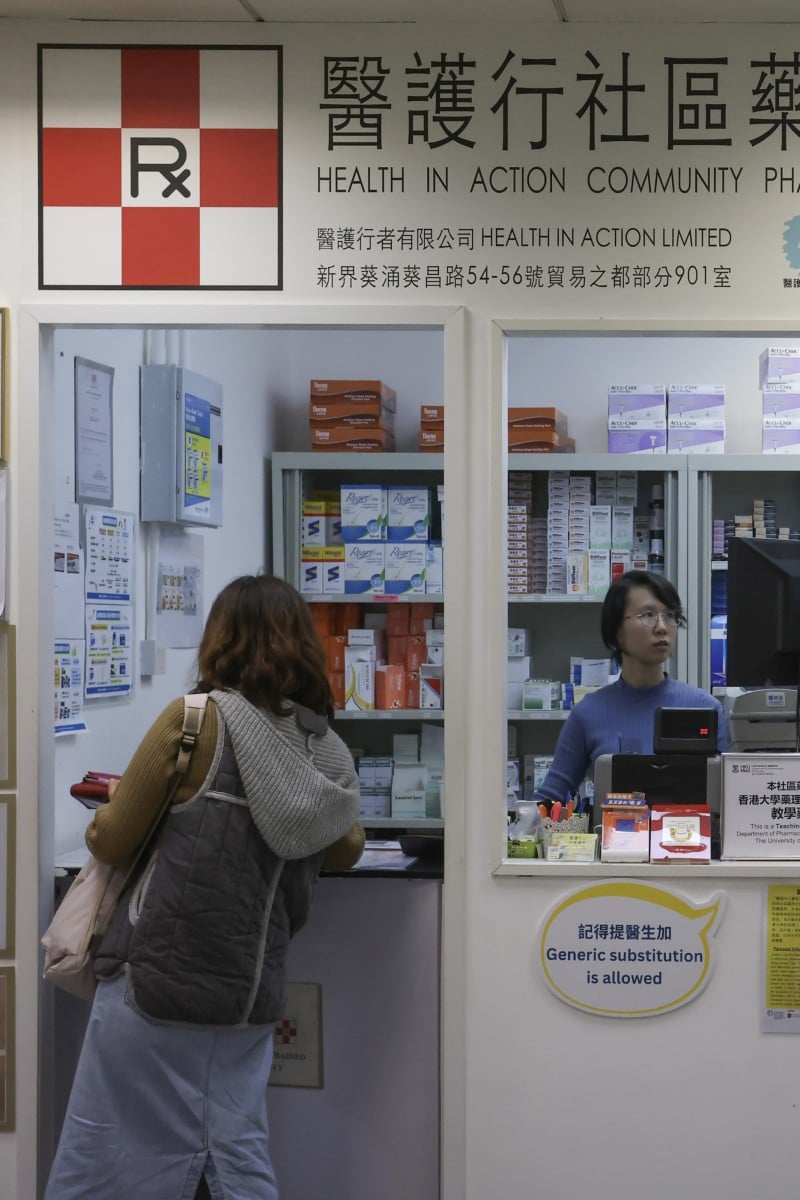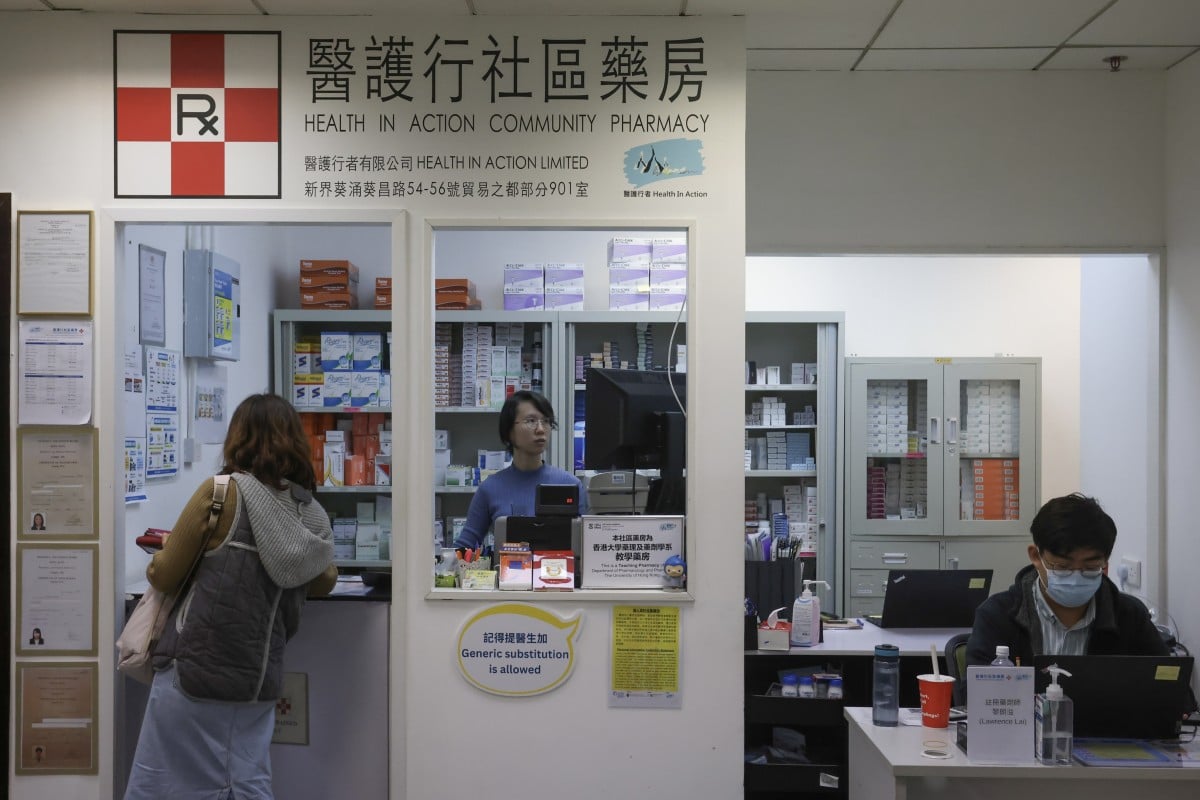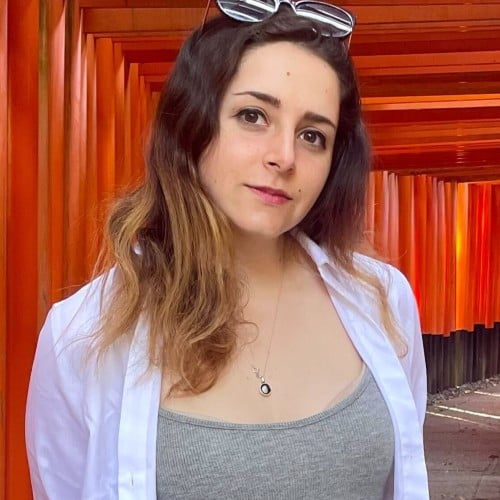
Deep Dive: Role of community pharmacies as Hong Kong aims to revamp public healthcare
These pharmacies could offer medical advice, monitor patients and dispense medication, relieving the burden on the city’s crowded hospitals
 A community pharmacy established by non-profit organisation Health in Action in Kwai Hing. Photo: Jonathan Wong
A community pharmacy established by non-profit organisation Health in Action in Kwai Hing. Photo: Jonathan WongDeep Dive delves into hot issues in Hong Kong and mainland China. Our easy-to-read articles provide context to grasp what’s happening, while our questions help you craft informed responses. Check sample answers at the end of the page.
News: How community pharmacies could help Hong Kong residents
-
City’s public healthcare system is overcrowded, as many visit the emergency room for non-urgent reasons
-
Community pharmacies could minimise costs, reduce wait time and dispense medications
Hong Kong retiree Yiu Po-tai, 81, has to gulp down 16 different pills every day to manage his chronic illnesses.
“I suffer from hypertension and had shingles two years ago. I still have not recovered from the nerve pain,” said the former construction worker. He lives alone in a subdivided flat in Sham Shui Po.
“I had a stroke 10 years ago ... and my face was paralysed twice around the time I had shingles.”
To manage nerve pain in his arms, Yiu also took medicine from doctors in mainland China, where service was faster, and from a local pharmacy, besides prescriptions in Hong Kong.
Yiu’s experience is common for patients with chronic illnesses. They often use various medications prescribed by different doctors. They take pills without realising that some may be duplicates or have adverse effects.
Fortunately for Yiu, a social worker noticed his situation and took him to a community pharmacy, where a pharmacist cut his medication to 13 pills.
Non-government organisations operate a number of community pharmacies. They provide medication management consultations, dispensing services and other healthcare resources.
The government will launch a community pharmacy programme late next year. Each of Hong Kong’s 18 districts will get at least four to five facilities.
Experts say community pharmacies could help reform the city’s healthcare system. They could be a gateway for patients to seek medical advice and obtain medication.
Health in Action founder Dr Fan Ning said the public healthcare system was overcrowded. Around 60 per cent of people in accident and emergency (A&E) wards are classed as non-urgent cases.
He said one reason for that was the public did not know where to treat mild conditions such as hypertension, chronic pain and acne while private clinics were expensive.
Community pharmacies could help manage mild conditions by providing medical and lifestyle advice and necessary medications, he said.
Patients’ rights advocate Tim Pang Hung-cheong said the community pharmacy programme would play an important role in healthcare reform.
“Community pharmacies can provide an alternative choice of services for conditions which can be managed by simple medications,” he said. “Some of the service demand at emergency rooms can be transferred to community pharmacies.”
Staff writer
Questions
1. Based on the information in News, which of the following is true?
(1) Seeing a doctor in Hong Kong is often faster than in mainland China.
(2) When Yiu went to the community pharmacy, they advised him to increase his pill intake.
(3) Hong Kong’s public hospitals are crowded because many don’t know where to treat mild conditions.
(4) Community pharmacies could provide lifestyle and medical advice as well as medications.
A. (1), (2) only
B. (1), (3) only
C. (2), (4) only
D. (3), (4) only
2. Using News, list TWO problems patients can have when using medications prescribed by different doctors.
3. Using the information from Fan and Pang, explain TWO ways community pharmacies could help the public.
Cartoon
Question prompts
1. What is being shown in the cartoon? What does it symbolise?
2. Based on News, Glossary and your own knowledge, how could a community pharmacy benefit your neighbourhood?
Issue: Community pharmacies could play a key role in Hong Kong’s healthcare reform
-
Hong Kong looks to revamp public healthcare system, citing abuse and wastage of medical services
-
Community pharmacists could help advise patients and monitor side effects
Hong Kong health authorities announced a revamp of the city’s public healthcare subsidy scheme last month, which included raising A&E department fees from HK$180 to HK$400, effective from January 1 of next year.
Under the revamp, patients at general outpatient clinics will need to pay an extra HK$5 for a four-week supply of each drug. Specialist outpatient clinic attendees will have to pay HK$20 for a four-week supply of drugs, up from HK$15 for 16 weeks.
The changes aim to reduce the abuse and wastage of public medical services.
Health officials have said community pharmacies could procure commonly used medications for chronic or occasional illnesses from the Hospital Authority and provide drug-dispensing services. To qualify, the pharmacies must have a registered pharmacist who has received certain training in primary healthcare.
Professor Ian Wong Chi-kei, head of the department of pharmacology and pharmacy at the University of Hong Kong (HKU), said that in the United Kingdom, community pharmacists also dispensed drugs for public hospitals, with patients collecting them every month.
“One of the benefits is that you do not have to store a large amount of drugs at home … Hong Kong is very humid, and it can be an issue to store six months of drugs at home,” said Wong.
“Another benefit is that it can reduce wastage. If you have to switch to another medication and you have six months of drugs at home, you will need to throw them away.”
Deep Dive: Hong Kong hopes foreign nurses can fight shortage
Wong said pharmacists also answered questions and observed whether the patients had taken their medicine or had side effects.
“We know that many patients may have stopped taking medicines due to the side effects or lack of understanding of their purposes,” he said.
“In hospital settings, pharmacies are often filled with long queues, leaving pharmacists with limited time to chat with patients.”
Meanwhile, So Yiu-wah, president of the Society of Hospital Pharmacists of Hong Kong, said it was expected that patients would be designated to a specific pharmacy so they could develop a long-term relationship there and their medicine could be collected at a fixed location.
In addition, if community pharmacists discover irregularities in a patient’s medicine intake, they could contact hospital pharmacists, who could tell the doctor in charge.
Staff writer
Question prompts
1. Based on the information in Issue, which of the following is true?
(1) Hong Kong’s healthcare reforms aim to minimise waste.
(2) A&E department fees are going to decrease beginning next year.
(3) Hong Kong’s humidity threatens the efficacy of drugs kept at home for too long.
(4) In the proposed revamp of the public healthcare subsidy scheme, patients at general outpatient clinics will pay more for their medication.
A. (1), (2) only
B. (2), (3) only
C. (1), (3) only
D. (2), (4) only
2. Using the information in Issue, list TWO ways that proposed revamps to the city’s public healthcare system could impact the community.
3. According to News and Issue, how could community pharmacies minimise waste in the healthcare system?
Graph
Question prompts
1. Note TWO trends observed in the graph.
2. How does this information relate to the government’s plans to review the healthcare system? Explain using News, Issue, Graph and your own knowledge.
Glossary
chronic illnesses: long-term health conditions lasting for a year or more that require continual medical attention. Sometimes, these conditions do not have a cure but are manageable with treatment, proper care and lifestyle changes. Examples of chronic illnesses are diabetes, asthma, heart disease, and arthritis.
hypertension: also known as high blood pressure. It is a medical condition in which the blood pressure in the arteries is higher than it should be. The heart has to work harder to pump blood. It can lead to more serious problems, such as heart disease.
shingles: a viral infection from the same virus that creates chickenpox. When people recover from chickenpox, the virus can remain inactive in their bodies for a long time and return as shingles later in life.
stroke: a medical emergency that happens when the blood flow to the brain is stopped or interrupted. It prevents the brain cells from getting the necessary oxygen and nutrients and can lead to permanent damage or even death.
community pharmacy: also known as a retail pharmacy or drug store, it is where the public can collect their medications and get advice about their health. They could be small, individually owned businesses or even large chains in shopping centres and supermarkets.
general outpatient clinics: medical facilities where people can get care without needing to go to the hospital overnight. They typically offer consultations, minor treatments and diagnostic tests.
Sample answers
News
1. D
2. When patients use different medications prescribed by different doctors, they might be taking the same pills twice or take pills that have adverse effects, either on their own or when taken with another medication.
3. According to Dr Fan and Pang, public hospitals are very crowded. Community pharmacies give people another option for non-emergency cases. This will minimise queues at hospitals while giving people the treatment they need. They can also help patients manage mild health conditions by providing medical and lifestyle advice and necessary medications.
Cartoon
1. The cartoon shows a community pharmacy shaped like a drug bottle with pills on the side. There are many people lined up for the community pharmacy, including a child and an elderly person. The building is glowing while the rest of the neighbourhood is dim, symbolising how it can benefit the community. The long line indicates that the community pharmacy would be popular and help many different people.
2. Answers will vary. [i.e., it can help my grandparents understand their medicines better, reduce the queues at public hospitals, etc.]
Issue
1. C
2. Under the proposed healthcare revamps, the fee for the A&E department will rise significantly - more than double - and drug prices will increase. While this may prevent abuse of the system and cut queues, it will stretch the wallets of those without financial stability, especially elderly populations. People may decide not to go to the hospital in an emergency because they cannot afford it. (accept all reasonable answers)
3. Community pharmacies will make it easier for patients to get their medicines, given their close proximity and generally smaller queues. As Wong mentioned, patients could get their drugs monthly rather than six months at a time. Hong Kong’s humid weather can ruin drugs that are stored at home for too long, so this can keep them from going bad, thereby reducing waste. (accept all reasonable answers)
Graph
1. The graph shows the strain on public hospitals, including the number of A&E attendances, around two million each year. It also shows that of these two million, more than 90 per cent are subsided, meaning they are partially or fully paid for by the government. Only forty per cent of these cases are urgent, while 60 per cent are not .
2. This graph shows that a majority of A&E cases are not critical or life-threatening, meaning many people use these services when it is not necessary. This ties back to authorities’ desire to revamp the system to minimise abuse. Many people do not know where to go for mild issues - especially since private doctors can be expensive - so they go to the emergency department. They could instead go to community pharmacies, which would help public hospitals save time and resources.
